In the Name of Research, We Spent the Day Eating and Drinking on Copacabana Beach
It was a tough job, but someone had to do it.
In the Name of Research, We Spent the Day Eating and Drinking on Copacabana Beach
It was a tough job, but someone had to do it.

The general consensus on Rio’s fine food scene is that, relative to other cities of global stature, it punches below weight. But then again, Rio obliterates the field when it comes to sun, sand, flip-flops, and lazy days on the beach – where there’s always something delicious to nibble on.
On Rio’s beaches, food and drink find their way to you. Bring a little wad of cash, rent a chair, claim your spot, and you’re set for hours. The Olympic event going on out yonder is an added bonus – the beach and its culinary traditions are a constant. Of course, I’m not here for leisure. It’s my job to sit here on the warm white sand as the waves come crashing in beneath the wheeling frigatebirds and stunning jagged topography, watching the Olympic swimmers, waiting for food and drink to appear. This is my job and I take it seriously. Will there be beer guys this early on a Monday?
This is my job and I take it seriously. Will there be beer guys this early on a Monday?
A henna tattoo vendor comes by, followed by a guy selling cangas, the all-purpose, boldly patterned cloths that have a million handy uses on the beach, and then, right around 9:30 am, I spot my first bit of beach food.
Luis Carlos wanders up with skewers of shrimp. He says he buys them fresh each morning over in Niteroi, the city opposite Rio on the Guanabara Bay, and cooks them himself. The Guanabara Bay is the place that’s gotten all the bad press about dirty water; I’m just going to assume the shrimp were actually caught elsewhere. Regardless, I’m starting in the beach food deep end here. “Don’t eat the shrimp,” locals will tell you sternly, being a perishable product carted around for who knows how long under the sun and all. But I’m a journalist and I knew going in it wouldn’t always be safe or comfortable. Some of us cover wars and disasters; some sit on Brazilian beaches eating shrimp. With a little squeeze of fresh lime, it tastes just like shrimp with a hint of freshly-squeezed lime.
Moments later, JoÁ£o rolls up with Biscoito Globo, an airy, crunchy, donut-shaped Rio beach staple made from tapioca starch and coconut oil. There’s a sweet version and a salty version. I go salty. (I could have sworn I saw a beer vendor heading my way while I was giving JoÁ£o money, but now he’s vanished.) Biscoito Globo are a perfect snack, crunchy and messy and salty (or sweet, if you prefer) and very satisfying despite being 99 percent air.
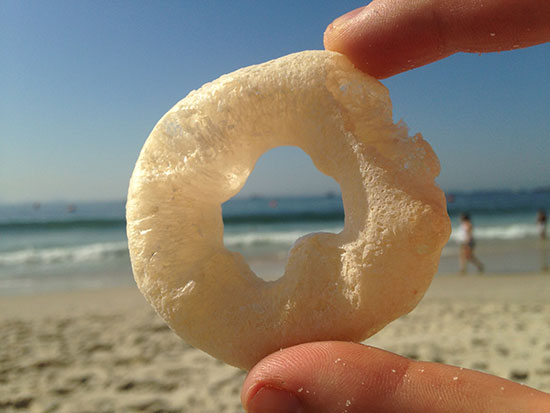
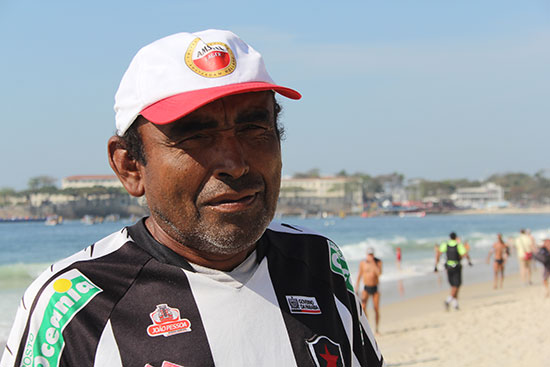
The swimmers are making their first pass directly in front of me, near the end of their first lap, still bunched up in a tiny, splashing pack that bobs in and out of sight among the waves.
The day’s first beverage turns out to be mate (more on this soon) cut with lemonade, toted across the beach in giant metal vats – one for mate, one for lemonade – hanging from the shoulders of a wiry guy named Ligerinho. He says he gets up at 4 every morning to prep, commute, and hit the beach by 8:30 am. He works all day, seven days a week. The two vats weigh somewhere around a combined 50kg when full, he figures (that’s about 110 pounds). He’s been working the beach for 25 years, and shows off a laminated newspaper clipping that documents when the city designated him an official Cultural Monument, being a long-tenured and widely admired beach vendor. He has a certificate, too, made out to Luiz Soares da Silva. Everyone just knows him as Ligerinho, though. Brazilians love nicknames.

Mate (pronounced mah-tay) is a caffeinated South American herb (tree leaf actually) that they drink hot down in southern Brazil and Argentina, out of gourds through metal straws. Ligerinho says that this beach mate – prepared as a dark, sweet beverage and served cold – is similar but not quite the same. It’s hard to determine if he means it’s from a related plant, or if the difference is simply the method of preparation, because he’s coy about his own proprietary special Cultural Monument mate.
“It’s a secret. I couldn’t tell you,” he says, in a very friendly sort of way.
It has a licorice-y sort of flavor. Who cares really, what exact relationship it has with hot mate? Good stuff.
There was definitely a beer guy that came by while Ligerinho and I were talking. He’s gone again, but Ivan the ice cream man has appeared in his stead, wearing mirrored Morpheus shades. I buy a jabuticaba popsicle. Jabuticaba is one of about a million exotic Brazilian fruits. A jabuticaba popsicle isn’t the best way to get acquainted with the essence of the the fruit – that common-denominator, sugary-popsicle taste kind of overwhelms the sweet, purple-hued jabuticaba – but, still, it would be a shame to be in Copacabana and settle for raspberry or strawberry.
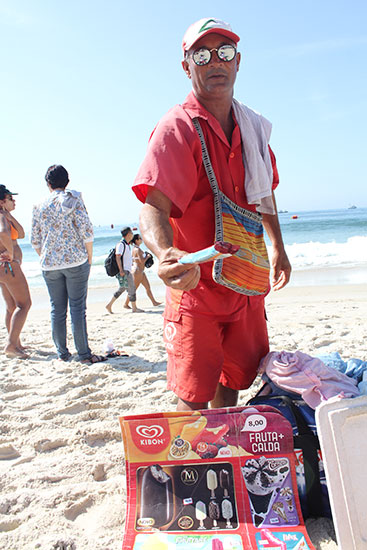
While I’m on the subject, let me just say that Brazilian fruits will blow your mind. The exotics – jabuticaba, butiÁ¡, pitanga, pitaya, ad infinitum – are a whole new world of flavor and color and beauty unto themselves. The familiar bananas, tangerines, and pineapples are the same as our US supermarket varieties in appearance only. But the taste! So bold! So much more banana-y or tangerine-y than you ever knew was imagined! Remember how it was the first time you shot a gun, or turned your guitar amp up to 10, or got laid, or did whatever else that made you feel suddenly more intensely alive? Come to Brazil and eat a pineapple.
Remember how it was the first time you shot a gun, or turned your guitar amp up to 10, or got laid, or did whatever else that made you feel suddenly more intensely alive? Come to Brazil and eat a pineapple.
The swimmers are finishing their second lap.
Yes! The beer guy finally made it and I have a can in hand. The seller is shy and won’t reveal his name or stay to chat. He had Brahma, Itaipava, and Antartica, three of Brazil’s variations on the light lager. They’re bem gelada – really cold – which is a must with these beers. I got a Brahma, and I want to be clear that I wouldn’t be drinking beer on the beach at 10 on a weekday morning if it wasn’t my job to hold Rio’s beach cuisine to the bright light of scrutiny.
At 10:19, I score an aÁ§ai from another non-chatty vendor. AÁ§ai is another one of those exotic Brazilian fruits, though unlike jabuticaba, it’s made inroads on the US scene. You’ve probably heard of it. On the beach, it comes in little ice cream cups, frozen like a sorbet and eaten with a little wooden spoon. AÁ§ai has it’s own unique and wonderful flavor, but my favorite thing about it is the pulp’s fine, gritty mouthfeel. You could probably brush your teeth with it, and I mean that as a compliment.
Vendors are coming fast and furious now. I have passed up multiple opportunities to get more Globo Biscoito and a second popsicle. Another beer guys comes past, but I’m still working on the Brahma, which is getting warm and pairs not well with the aÁ§ai.
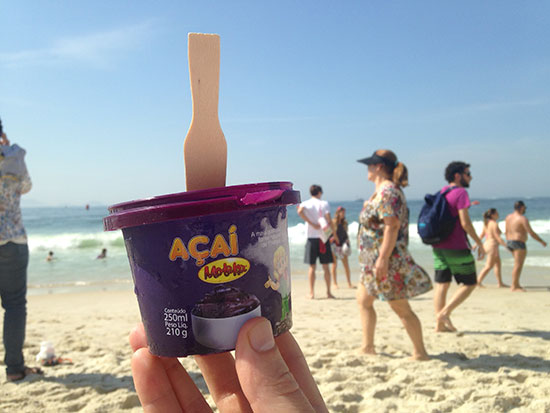
The marathon swimmers pass in front of me once again, finishing up their third lap, still tightly grouped except for one who’s fallen a couple dozen kayak lengths back.
A while later, a genial guy named Vitor wanders up with several massive caipirinhas on a tray. Caipirinhas are Brazil’s major take on the cocktail, basically just cachaÁ§a and limes. I ask Vitor if he has any smaller ones. Negative. I really, really wouldn’t have bought one of the giant ones if it wasn’t my duty. It comes in a plastic cup and isn’t high-brow mixology, but this is the beach and high-brow doesn’t belong. Vitor tells me the brand of cachaÁ§a – Brazil’s national spirit, made from pressed sugar cane – but I either heard him wrong or he was pulling my leg or the brand is so obscure that even Google can’t pull it up, so that bit’s just going to be a loose end.
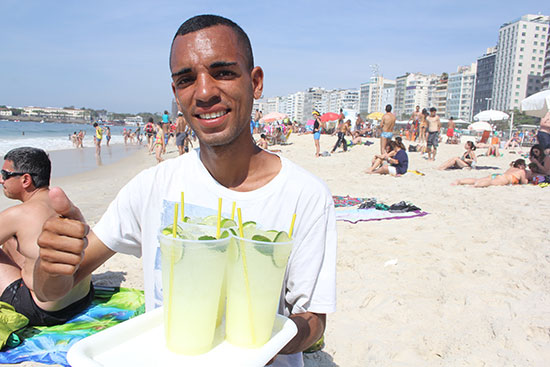
The beach is packed with beachgoers now, and Copacabana is absolutely crawling with Biscoito Globo sellers. I am very full and still have a whole lot more caipirinha to finish. The aquatic marathon is finishing, and through my binoculars, I see a swimmer in a white cap cross the line first. She’s Dutch, according to some friendly beach neighbors listening on the radio. As I leave the beach, I finish up my day at the office with a coconut from Leo. He bores a hole in it and hands me a straw. Perfect.
Follow us
This work is licensed under a Creative Commons Attribution-NoDerivatives 4.0 International License.
Want to republish a Modern Farmer story?
We are happy for Modern Farmer stories to be shared, and encourage you to republish our articles for your audience. When doing so, we ask that you follow these guidelines:
Please credit us and our writers
For the author byline, please use “Author Name, Modern Farmer.” At the top of our stories, if on the web, please include this text and link: “This story was originally published by Modern Farmer.”
Please make sure to include a link back to either our home page or the article URL.
At the bottom of the story, please include the following text:
“Modern Farmer is a nonprofit initiative dedicated to raising awareness and catalyzing action at the intersection of food, agriculture, and society. Read more at <link>Modern Farmer</link>.”
Use our widget
We’d like to be able to track our stories, so we ask that if you republish our content, you do so using our widget (located on the left hand side of the article). The HTML code has a built-in tracker that tells us the data and domain where the story was published, as well as view counts.
Check the image requirements
It’s your responsibility to confirm you're licensed to republish images in our articles. Some images, such as those from commercial providers, don't allow their images to be republished without permission or payment. Copyright terms are generally listed in the image caption and attribution. You are welcome to omit our images or substitute with your own. Charts and interactive graphics follow the same rules.
Don’t change too much. Or, ask us first.
Articles must be republished in their entirety. It’s okay to change references to time (“today” to “yesterday”) or location (“Iowa City, IA” to “here”). But please keep everything else the same.
If you feel strongly that a more material edit needs to be made, get in touch with us at [email protected]. We’re happy to discuss it with the original author, but we must have prior approval for changes before publication.
Special cases
Extracts. You may run the first few lines or paragraphs of the article and then say: “Read the full article at Modern Farmer” with a link back to the original article.
Quotes. You may quote authors provided you include a link back to the article URL.
Translations. These require writer approval. To inquire about translation of a Modern Farmer article, contact us at [email protected]
Signed consent / copyright release forms. These are not required, provided you are following these guidelines.
Print. Articles can be republished in print under these same rules, with the exception that you do not need to include the links.
Tag us
When sharing the story on social media, please tag us using the following: - Twitter (@ModFarm) - Facebook (@ModernFarmerMedia) - Instagram (@modfarm)
Use our content respectfully
Modern Farmer is a nonprofit and as such we share our content for free and in good faith in order to reach new audiences. Respectfully,
No selling ads against our stories. It’s okay to put our stories on pages with ads.
Don’t republish our material wholesale, or automatically; you need to select stories to be republished individually.
You have no rights to sell, license, syndicate, or otherwise represent yourself as the authorized owner of our material to any third parties. This means that you cannot actively publish or submit our work for syndication to third party platforms or apps like Apple News or Google News. We understand that publishers cannot fully control when certain third parties automatically summarize or crawl content from publishers’ own sites.
Keep in touch
We want to hear from you if you love Modern Farmer content, have a collaboration idea, or anything else to share. As a nonprofit outlet, we work in service of our community and are always open to comments, feedback, and ideas. Contact us at [email protected].by Andrew Jenner, Modern Farmer
August 17, 2016
Modern Farmer Weekly
Solutions Hub
Innovations, ideas and inspiration. Actionable solutions for a resilient food system.
ExploreExplore other topics
Share With Us
We want to hear from Modern Farmer readers who have thoughtful commentary, actionable solutions, or helpful ideas to share.
SubmitNecessary cookies are absolutely essential for the website to function properly. This category only includes cookies that ensures basic functionalities and security features of the website. These cookies do not store any personal information.
Any cookies that may not be particularly necessary for the website to function and are used specifically to collect user personal data via analytics, ads, other embedded contents are termed as non-necessary cookies.